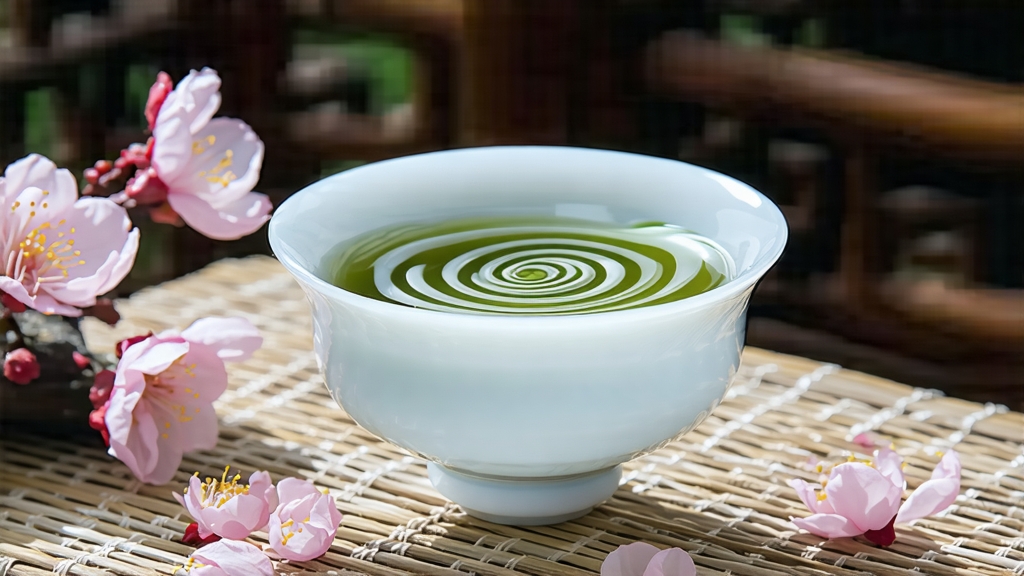
Among the countless shades of green that paint China’s tea landscape, none curls as delicately or perfumes as mysteriously as Biluochun. Its name, literally “Green Snail of Spring,” hints at both appearance and season: tiny, spiral-shaped leaves, plucked when the hills of Jiangsu are still wearing apricot blossom. To the uninitiated, the tea looks almost ornamental; to the seasoned drinker, it is liquid topography, a cup that carries lake mist, orchard breeze and centuries of imperial gossip.
Origin myths swirl like the steam above a gaiwan. The most quoted dates to the late Kangxi era (17th c.). Legend claims a tea picker, her basket already brimming, slipped the last tender shoots into her bodice to keep them from bruising. Body heat lightly oxidized the leaves, releasing an uncanny fragrance that startled passing monks. The emperor, touring the region incognito, tasted the brew, praised its “scary greenness” (xia sha ren xiang) and renamed it Biluochun to tame its wild aroma. Whether apocryphal or not, the story underlines two truths: the tea was already famous among Suzhou literati, and its perfume is so intense it seems almost alive.
Geography is the first co-author of this cup. The plants grow on the east and west peninsulas of Lake Tai, China’s third-largest freshwater body. The lake acts as a thermal regulator, wrapping the hills in a humid cocoon that delays spring warmth and concentrates aromatics. Between rows of tea bushes, fruit farmers plant peach, plum, loquat and bayberry; their blossoms fall like snow, composting into the sandy loam and lending a subtle honeyed note to the leaf. No other Chinese green possesses this built-in orchard terroir.
Cultivars matter, yet are rarely discussed abroad. The original heirloom is the small-leaf “Dongting群体种” (qunti zhong), hardy, slow-growing, naturally low in tannins. Since the 1980s, clonal selections such as Fuding Dabaicha and Wuniuzao have been grafted in to extend the picking window, but connoisseurs still chase the qunti zhong for its lingering orchid finish. Nurseries now fingerprint mother trees with RFID tags to guarantee genetic purity—an anti-counterfeit measure in a market where one kilogram of top-grade Biluochun can trade for the price of gold.
Plucking is ballet on a stopwatch. Only the “single bud with one unfolding leaf” (qiyi zhai) is taken, ideally 1.5–2 cm long, before seven in the morning when dew still glistens. A skilled picker collects barely 500 g of fresh leaf in four hours; five kilograms are needed to yield one kilogram of finished tea. The work is measured in steps, not hours—108 backward shuffles along the hedge constitute one “round,” after which the picker must rest her thumbs to avoid bruising the next shoot.
Withering is done outdoors on bamboo mats for no more than thirty minutes, just long enough for the lake breeze to evaporate surface moisture. The real magic happens in the wok. Unlike Longjing’s signature pressing technique, Biluochun craftsmen “rub and roll” in a 180 °C iron pan for three minutes, then lower the temperature to 70 °C for another twenty. Fingers flick, tuck, and spiral the leaves against the metal, coaxing them into the tight snail shape that traps aromatic oils. The motion resembles calligraphy: wrist erect, thumb and index forming a ring, each stroke both gentle and decisive. When the leaf feels “silkworm-cocoon firm” and emits a faint white down, the maker knows oxidation has been halted at the razor’s edge of green.
Firing is brief, almost an afterthought: sixty seconds over 60 °C charcoal embers to lock in fragrance, followed by a cooling interval on sieves lined with Xuan-paper. The entire process, from pluck to final rest, spans less than four hours—any longer and the volatile linalool and geraniol compounds would volatilize, leaving the tea flat.
Judging quality begins with the dry leaf. Top-grade Biluochun displays five whites: white tips, white fuzz, white sheen, white uniformity, and—when viewed under a